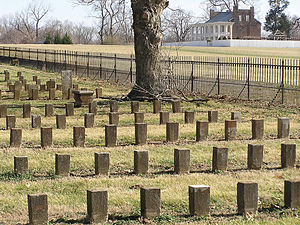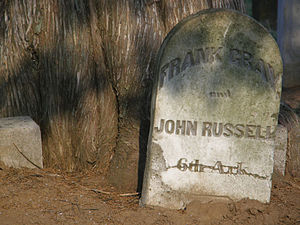- McGavock Confederate Cemetery
-
The McGavock Confederate Cemetery[1], , the largest privately held Confederate cemetery in the United States is located in Franklin, Tennessee. It was established on land donated by the McGavock planter family.
The nearly 1,500 Confederate soldiers buried there were casualties of the Battle of Franklin that took place November 30, 1864. While 780 of the soldiers have been identified, 558 are still unknown. Since 1905 the cemetery has been maintained by the Franklin chapter of the United Daughters of the Confederacy.
Contents
History
Main article: Battle of FranklinThe aftermath of the Battle of Franklin, which took place during the night of November 30, 1864, left a total of nearly 9,500 soldiers, Union and Confederate dead, wounded, captured or missing. More than 6200 were Confederate troops. Their final losses were estimated at 1,750 dead; 3800 wounded and the remainder missing or captured.
The population of Franklin in 1860 was just over 900. When Franklin residents awoke on the morning of December 1, their concern was how to bury thousands of soldiers and care for the wounded. Colonel John and Carrie McGavock's plantation home, Carnton, was situated less than one mile (1.6 km) from the center of the action that took place on the Union Eastern flank at Franklin. Due to its geographical proximity, Carnton served as the largest field hospital in the area for hundreds of wounded and dying Confederate soldiers.
Carrie Winder McGavock led the efforts, supervising the logistics, ordering slave workers, and donating food, clothing and supplies to care for the wounded and dying. Carrie's two surviving children, Hattie (age nine) and Winder (age seven), served as medical aides throughout the evening as well. At least 150 Confederate soldiers died the first night at Carnton.
Most of the Confederate (and Union dead) were buried by soldiers and workers "near and along the length of the Federal breastworks, which spanned the southern edge of what was then Franklin."[1]. Union dead were placed by twos in shallow graves in long rows by their comrades without marking the identities. Many of the Union dead were later removed either by family or loved ones, or by the military and relocated in graves at home, or reinterred at the Stones River National Cemetery in Murfreesboro, Tennessee. The 11th United States Colored Troops managed the reinterment of the Union soldiers at Stones River.[2]
It was not until the next day of December 1 that burial teams identified most of the 1,750 Confederate dead near Carnton. Soldier burial teams collected and identified their comrades. They placed makeshift wooden markers at the head of the graves to identify individuals by name, rank, regiment and company.
Most of the Confederate dead were buried on the properties of Fountain Branch Carter and James McNutt. Carter had the largest section of land with interments. He lost his own son, Todd Carter, in the Battle of Franklin. The Carter-McNutt land was temporary rest until the remains were transferred to a permanent cemetery some eighteen months later in June 1866.
Deterioration of the graves
By the spring of 1866, the condition of the graves and markers were worsening. Many of the wooden markers were beginning to be hard to read, and some had been used as firewood at a time of shortages. The full identities of these men were in danger.
The McGavocks of Carnton donated 2 acres (8,100 m2) of their property to be used as a permanent burial ground for the soldiers. Citizens of Franklin began raising funds to exhume and re-bury nearly 1,500 Confederate soldiers to the field just northwest of the Carnton house. With enough money raised to get started, the group paid George Cuppett to manage the re-burial operation. He was paid $5.00 for each soldier. The work was "done in order to have removed from fields exposed to the plow-share, the remains of all those who were buried," according to Col. John McGavock[3].
Cuppett was assisted by his brother Marcellus and two others. The entire operation took ten weeks and was completed in June 1866. Marcellus, 25 years old, fell ill during the process and died. He was buried at the head of the Texas section in the cemetery. George Cuppett wrote, "My hole (sic) heart is with the brave & noble Confederate dead who fell whilst battling for their writes (sic) and Libertys (sic)." (Jacobson: McGavock, p. 25)
Soldiers from every Southern state in the Confederacy, except Virginia, are represented in the cemetery. Wooden headboards with the soldier's personal identification were installed. Footboards were added in 1867.
McGavock Cemetery book
George Cuppett wrote the names and information related to the identity of each soldier in a cemetery book[4]. After he finished the re-burials in mid 1866, he turned over the care of the book to the McGavocks.
In 1896, the "John McEweb Bivouac" veterans organization raised funds to replace the wooden headboards with granite markers. Carrie McGavock managed the maintenance of the cemetery with African-American workers until her death in 1905. The original cemetery book is on display upstairs in the Carnton great house.
After 1905, the Franklin Chapter of the United Daughters of the Confederacy took over financial responsibility to maintain the cemetery. Today 780 Confederate soldiers’ identities are positively identified, leaving some 558 as officially listed as unknown.
The cemetery today
The cemetery is located off Lewisburg Pike just a few minutes from downtown Franklin. The graves take up a 2-acre (8,100 m2) section of the Carnton plantation property. The thirteen sections are organized by states.[5]. The two sections are separated by a 14-foot (4.3 m) pathway.
On the left side, upon entering are the following sections (with the number of dead buried in parentheses): left front row one will find North Carolina (2), Kentucky (5) and Florida (4). Next section, Unknown (225). Next section, Louisiana (19). Next section, South Carolina (51). Next section, Georgia (69). Next section, Alabama (129). Next section, Tennessee (230).
On the right side, upon entering are the following sections (with the number of dead buried in parentheses): Mississippi (424), the State with the largest number of men who died at Franklin. Next section, Arkansas (104). Next section, Missouri (130). Next section, Texas (89).
References
Further reading
- The McGavock Confederate Cemetery: A Revised and Updated Compilation. Eric A. Jacobson.
- The Carnton Association
- The Battle of Franklin
External links
- A blog-database for descendants of the Battle of Franklin
- McGavock Cemetery list of names {reference only}
- The McGavock Confederate Cemetery blog
- McGavock Cemetery video
- [http://www.WidowoftheSouth.com Robert Hicks, The Widow of the South, novel
- The Heritage Foundation of Franklin and Williamson County, Tennessee
Categories:- Confederate States of America memorials and cemeteries
- Tennessee in the American Civil War
- Franklin, Tennessee
- Protected areas of Williamson County, Tennessee
- Cemeteries in Tennessee
Wikimedia Foundation. 2010.


